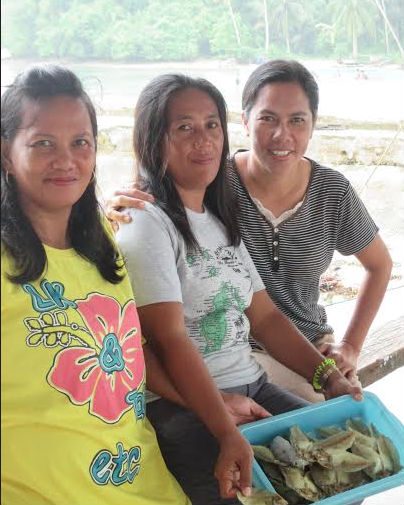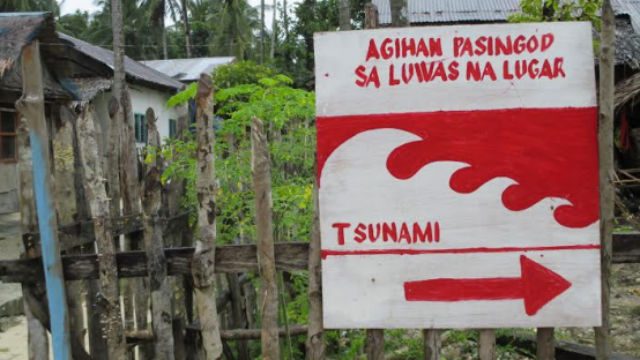SUMMARY
This is AI generated summarization, which may have errors. For context, always refer to the full article.

But with climate change threatening the coastal communities of Siargao, groups of women and men in different barangays of Del Carmen have decided to do things differently by venturing into alternative livelihoods to protect their marine resources.
Clawing at opportunity
Belen Tabaloc leads the way and proudly presents the training center of Kaanib ng mga Mangingisda at Magsasaka ng Numancia or KAMAMANA — a small hut on stilts almost hidden by a thick lush of mangroves. Beside it is a crab rearing pond, where the biggest of king crabs resides in a plastic container, getting fatter by the day before market time.
“We buy a 300-gram crab at P250 per kilo, feed it with fish and crushed shells for two weeks, and then sell it for P550 per kilo,” shares Belen who serves as treasurer of the enterprise. “Minus the costs in rearing crabs, each of the 20 active members of KAMAMANA can earn P2,000 from our monthly profit-sharing.” Sounds like a good deal overall, except most of the male members of KAMAMANA used to easily earn P2,000-4,000 a month by cutting mangroves and selling them as firewood.
Del Carmen’s mangrove forests – one of the largest in the Philippines – is nature’s most effective safeguard from storm surges. Cutting mangroves without a permit is illegal, but is often not enforced.
Recipe for environmental disaster
They say a lechon (roast pig) cooked using mangrove firewood tastes better. And even if Cebu, famous for its lechons, is an hour away by plane, demand for mangrove firewood in Siargao is high. As host to half of the island’s total mangrove forests, Del Carmen is considered the main supplier.
“Our goal is to generate income for households that can match their previous earnings from selling mangrove firewood,” said Chito Dugan, Executive Director of Sentro para sa Ikauunlad ng Katutubong Agham at Teknolohiya, Inc. (SIKAT). Dugan added that through Oxfam’s support they are able to provide initial capital and capacity building trainings for social enterprises.
SIKAT, an NGO set up in 1991, organizes highly vulnerable groups in coastal communities, and facilitates good governance and knowledge-sharing through a sustainable ecosystem-based management approach. Different livelihood projects are being launched in other barangays of Del Carmen, including the production of dried boneless danggit and wet stall stores.
“For each barangay, we try to counter illegal means of livelihood by promoting social enterprises designed to develop resilient island communities,” said Dugan. SIKAT also addresses factors affecting local enterprise such as environmental conditions, local policies, community capacities, appropriate technologies, and market access.
Forty-year-old working mother Leonie wakes up extra early in the morning to facilitate the operations of their dried boneless danggit enterprise.
Role of women
“I decide how many workers will be needed for the job considering the total kilos of fish. I assign the brusher, boner and drier among our members. I am also responsible for paying them the correct fee at the end of a day’s work,” said the mother of four.
Leonie is the business manager of Barangay Caub Marine Association or BACAMA, and the dried boneless danggit is their people’s organization (PO) livelihood project supported by SIKAT. During a good season, each BACAMA member earns about 1,000 pesos a month — a much-needed income for the members, who are mostly housewives of fisherfolk.
Other groups in their community have engaged in similar enterprises, having realized how profitable it is; but, because of the high market demand, Leonie said there is no reason to worry about the competition. She is concerned, however, about the effect of dynamite fishing on their abundant seagrass – the natural habitat of danggit.
“When our PO holds seminars on how illegal fishing is affecting our marine resources, those who are guilty don’t attend so they really don’t know how they are harming our environment,” shared a frustrated Leonie.
Since SIKAT supported their patrolling efforts, Leonie says the rate of illegal fishing has declined by about 50% in Del Carmen.

Resilient communities
Siargao’s proximity to the Pacific Ocean makes it vulnerable to typhoons and tidal waves, and Brgy. Caub is among the tsunami-prone communities.
“After Yolanda (Haiyan), we are always terrified during typhoons because we live next to the sea,” admitted Brgy. Caub Secretary and BACAMA member Jelly Calayag. “SIKAT organizes many trainings for BACAMA and Brgy. Caub, which are all useful, such as proposal making for our social enterprise, and those on illegal fishing and natural disasters,” she adds.
According to SIKAT, they had “zero casualty” even in the most trying typhoons since they piloted their disaster risk reduction (DRR) program in the area. “We conducted a drill on how people will evacuate to the safest area in the barangay during typhoons, and they used the system during the recent super typhoon Ruby,” said Dugan.
Dugan added that thriving social enterprises are a key component of SIKAT’s work on DRR and climate change adaptation in Del Carmen. Managing a small business teaches community members on how to reduce risks to their livelihoods by considering environmental threats and the adaptive capacity of the communities.
It’s a lesson that they hope other communities can take to heart. – Rappler.com
Abby Mercado is a storyteller of various nonprofit initiatives for poor communities in the Philippines, as well as in other countries in Asia and Africa.
About the title photo: Siargao Island’s 8,620 hectares of mangrove forests are one of the largest in the country. Photo contributed by SIKAT
Add a comment
How does this make you feel?
There are no comments yet. Add your comment to start the conversation.